Posted on 2013-Aug-06
There must have been a cancellation of someone more important, but I had the pleasure of being invited to speak to the American Chamber of Commerce in Thailand Small-Medium Enterprise (SME) Committee. Below is the presentation I gave plus the notes on why small business owners should focus more on writing books to help market their business. Also, included is some ideas for businesses to utilize eBook technology solutions for matters like configuration control, manual distribution, compliance, etc.
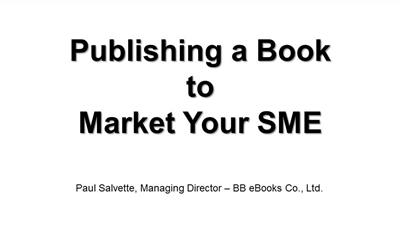
A Quick History of Publishing

The first moveable type presses were developed in China, but most people credit Johannes Gutenberg with the first press that allowed large-scale publication. It was intended to print bibles, but it became synonymous with the launch of the Renaissance and a more educated public.
Typically, people who wanted to publish a book would take their manuscript to a printer. The authors themselves were responsible for distribution. In American colonial days, Thomas Paine wrote Common Sense, which quickly catapulted the colonies into revolution. The book sold 100,000 copies throughout the colonies and it was pirated in numerous different forms.
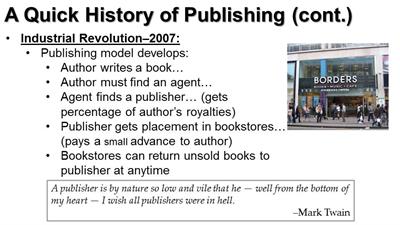
During the Industrial Revolution, the Agent-Publisher model began to take hold. An author would typically write a book and have to go through an agent to generate publisher interest. The agent would get their share of the royalties (typically 15%) and the publisher would usually pay out an advance. Over time the advances got smaller and smaller and the process took longer and longer. Publishers had the ability to get books into bookstores through their supply chain; however, booksellers could return unsold books the publisher… a rather strange business model.
Mark Twain was so frustrated with this model while he was trying to get The Adventures of Huckleberry Finn published, that he started his own publishing company in retaliation. It eventually went bankrupt.

In late 2007, Amazon released the first generation of Kindles. Suddenly, readers wanted to get books immediately without having to go to a bookstore or wait for a physical book to be mailed. Amazon also allowed authors to begin publishing their work directly on the Kindle Store. This had many unintended consequences that improved the literary world such as a closer relationship between an author and their readers. When authors control when a book is published, it allows them to market more effectively. Eventually, readers became more demanding, such as asking for authors to write books in series – often within weeks of each other. This type of consumerism is not possible under the legacy publishing model where books can take over a year to go from an author’s finished manuscript to a bookstore. Using the Kindle store, an author can get their book to mass market in less than 24 hours.
The New Paradigm of Independent Publishing
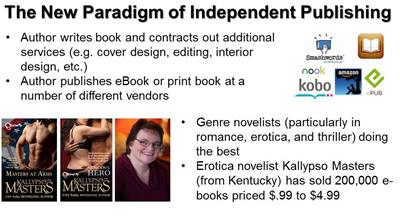
The new paradigm of publishing involves the author as a professional or SME owner, where they contract out the necessary services for book production, such as cover design, editing, interior design, etc. The author can use the worldwide distribution of vendors like Amazon (70% market share) Kobo (~5% market share), iTunes (~5% market share), Nook (~20% market share in the USA), so their fans can buy their books. eBooks are the hottest sellers for genre novels, but many authors also make a “Print-On-Demand” edition that allows physical books to be shipped.
Kallypso Masters is a grandmother from Kentucky and client of ours who went independent and has sold over 200,000 eBooks and given away more than 300,000! The advent of eReading devices has seen tremendous growth in erotica and romances, which can be explained by the fact that people are allowed to read privately. Also, women read much more frequently than men.
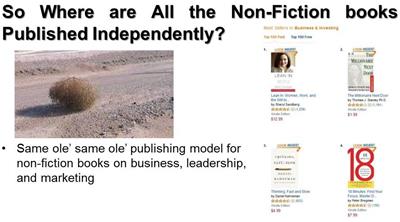
Where is all the Non-Fiction?
So why isn’t there a revolution in non-fiction publishing like there has been with fiction? If you look at the Top 100 Amazon Best sellers in Business & Investing, you see the same old names from the big publishing companies. BTW Sheryl Sandberg’s book was horribly written and the cover is lousy. Who uses Helvetica on a cover? The reason has to do with the fact that there hasn’t been a big movement among non-fiction writers toward independence like there has been with fiction. Largely this is due to the fact that many publishing companies really upset genre authors with decreasing advances, poor marketing support, etc. Most business leaders who write business books are probably not that interested in going through the motions to publish their own book.
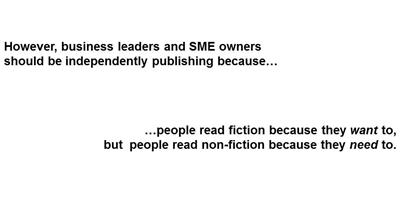
However, business leaders and SME owners should be interested in publishing their own. Having a book with your name on it will help establish credibility in your field and indirectly market your business through content marketing. This form of marketing allows people to find you rather than you trying to advertise your business. When I was starting my own business last year, I didn’t know what the hell I was doing. If anyone in this room had written a book called “Doing Business in Thailand” or “How Not to Get Ripped Off in Thailand” I would have snapped it up immediately.
Step 1: Sit Down and Write
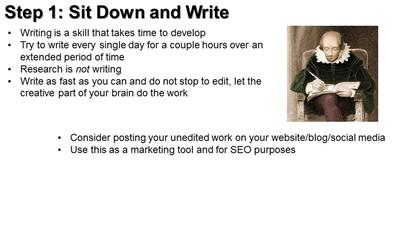
Writing is a process that can take years to perfect. Luckily, for business leaders and SME owners, the reader is more interested in your guidance and wisdom than your ability to spin a yarn. Write in a place that is quiet, disconnected from the outside world, and allows you total concentration. A big mistake for people writing their first book is to write slow. You should let the creative part of your mind do most of the work, which will allow for more compelling and free-flowing narrative. You can go back and verify technical information and grammatical correctness at a later time.
The nice part about writing non-fiction is that it is an easy way to attract potential readers via SEO. No need to be pushy with your book, and if you write about your subject field the “right” kind of people (and potential clients) will find you.
Step 2: Editing
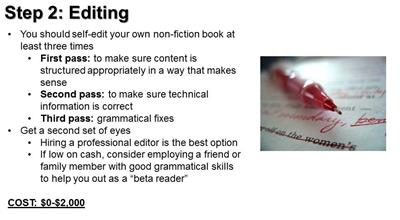
Every writer needs an editor, even Stephen King. It helps to due numerous passes on your manuscript to look for different things. Editing is NOT writing and uses a different part of the mind. For non-fiction books, we recommend at least three passes. On your first pass, make sure your content is ordered correctly, makes sense, and gets the point you would like to get across. The second pass involves some research to make sure your technical information is correct (such as specific facts and figures you may cite). The third press should focus on grammatical correctness and fixing up typos.
Editors are a great resource person and will be able to tell if the theme of you book makes sense. They can be expensive though and the process is time-consuming. Consider using friends or family members to help you out if cash flow is an issue. A lot of fiction and non-fiction writers use this technique, even some of the big names.
Step 3: Cover Design
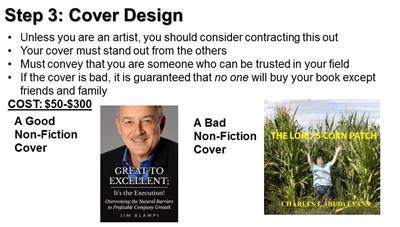
The cover design is more important than you think. Your eBook will appear as a small thumbnail surrounded by the covers of other books in your field. You must make a good first impression. Additionally, for non-fiction, your cover must establish your credibility in the field. No one wants to buy a book to further their professional development from a bum.
Step 4: Interior Design/Book Production

There are basically only two types of eBook formats: EPUB and MOBI. EPUB is an open standard that has been developed by a consortium of publishers, technical groups, and librarians. It is used by almost every eBook vendor EXCEPT Amazon. MOBI is the eBook format used exclusively by Amazon on its Kindle store and for its devices. Luckily, the two formats are very similar and production costs are only charged for one format since they are quite interchangeable. Unlike PDF, eBook formats are designed to work on any sized device on a wide variety of different software programs.
For print, PDF is still the preferred format used by publishers and independents and it is widely in use. The two major Print-On-Demand providers (CreateSpace and Lightning Source) only use PDF for print interiors. PDFs should NOT be used as an eBook format, as it is based on a fixed page layout size, which completely defeats the purpose of an eBook to be functional on a wide range of devices.
There are some open source programs on the market if you want to try doing your own interior. However, for complicated formats that require extensive functionality, we recommend contracting this out.
This is the piece that BB eBooks gets involved with for our clients.
Step 5: Publish and Market
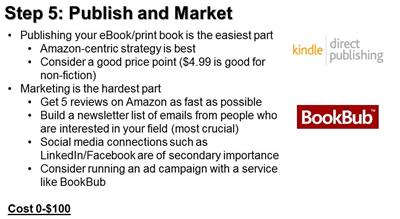
Publishing your book is very easy. Do not listen to any advice you see online that says otherwise. You need a Social Security Number or an ITIN, your eBooks and your covers, and you’re ready to publish at most platforms.
Marketing a book is very challenging if it is your first book. Luckily, non-fiction is a bit easier since you can adopt a content marketing approach and gather interested people’s email addresses. Don’t listen to the hype about social media (although it can be useful): email is the best way to launch your book—especially for non-fiction. Once you publish, it is critical that you get at least 5 honest reviews as quickly as possible on Amazon. This will help Amazon’s algorithms list your book when people are looking for certain types of books.
Beyond eBooks and Writing…
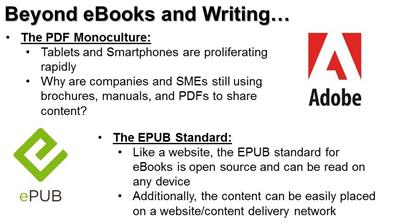
People are reading content on a wide variety of platforms. I don’t need to condescend to this group by showing you facts and figures about this—just take a ride on the Skytrain.
However, most companies still prefer to use printed materials and/or PDF to share advertisements, training manuals, compliance manuals, etc. Why can’t this content be in an eBook format that can be easily read on any device?
The eBook standard (EPUB) is entirely based on existing web technologies that can be easily read on any sized device. This is a more appropriate solution for SMEs to disseminate content.
A Better Way to Do Business
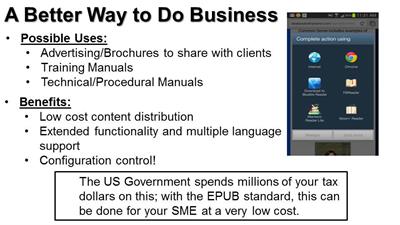
When I was in the Navy, I was one of the poor junior officers responsible for making sure all our nuclear manuals were up to date. We used to get these pages mailed in this brown wrapping and have to manually insert them into the numerous manuals found throughout the engine room. Welcome to 1963! It was a huge pain, I messed it up all the time, and probably cost the taxpayers a fortune. Why not have a solution to do this electronically?
A more recent example: we were writing the work principles manual for BB eBooks and the Thai government gave us the labor law printed out. Why not just have an eBook or website where content could be accessed quickly? Cut and paste is a godsend and would ensure better legal compliance. I hope they gave us the most recent labor law.
Using technology that is already in existence, you can have a single eBook format that distributes to numerous places. Any changes you need to make can be done to that one file and re-distributed very quickly at very little cost. This would be a huge boon for SMEs.
Label: Self-Publishing
comments powered by Disqus